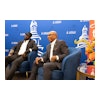The Black Issues Quiz, or BIQ offers you the opportunity to test
your knowledge on the people, places, issues, and history surrounding
the struggle for academic equity. Each question is based on information
published in the current or previous editions of Black Issues In Higher
Education and is worth ten points.
A perfect score of 100 grants membership in the prestigious — and
mythical — Phi BIQeta Kappa honors society: a score of 80 to 90 grants
membership in the Honor Society of Not So BIQ Brains; and a score of 50
or below grants membership in the Reading Black Issues Is Fundamental
program.
Think you’re smart? Go ahead, give it a try! (Answer key appears at the bottom of the page.)
1 In 1997, what was the percentage of African Americans in the
student population at historically Black Bluefield State College?
A — 77 percent B — 90 percent C — 7.7 percent D — 50 percent
2 A group of minority recipients of which fellowship has decided to
establish their own fund to increase the number of doctoral fellowships
that the foundation gives?
A — Ford Foundation B — Merck Foundation C — Lilly Foundation D — Sloan Foundation
3 Between 1991 and 1995, the number of bachelor’s degrees bestowed upon African Americans rose:
A — 10 percent B — 20 percent C — 30 percent D — 40 percent
4 What was the final outcome of the Piscataway School Board case,
in which a White teacher sued the New Jersey board because she was
fired while a Black teacher with allegedly similar qualifications was
retained to satisfy a diversity policy?
A — The Supreme Court ruled in favor of the plaintiff. B — The
Supreme Court ruled in favor of the defendants. C — The case was
settled out of court. D — The case was dismissed.
5 A White graduate student at Clemson University won a suit against
which organization over its Minority Graduate Research Fellowship
program?
A — National Science Foundation B — National Institutes of Health
C — National Aeronautics and Space Administration D — U.S. Department
of Education
6 How much federal funds did historically Black colleges and universities and their graduate schools get in 19987
A — $108.9 million B — $128.5 million C — $143.5 million D — $178.3 million
7 An Alfred P. Sloan Foundation program aimed at increasing the
number of underrepresented minority doctorate holders in the sciences
gives funding to:
A — institutions B — students C — faculty D — all of the above
8 According to the University of California-Davis, which group of
students experienced the largest increase in freshman admits between
the fall of 1997 and the fall of 19987
A — Whites B — Asians C — Native Americans D — Declined to state ethnicity
9 Which college professor received the Medal of Freedom from President Bill Clinton in January 19987
A — James Farmer B — Maya Angelou C — Dr. Molefi K. Asante D — Dr. Roscoe C. Brown
10 Who chairs the American Council on Education’s Commission on the Status of Women?
A — Lani Guinier B — Dr. Yolanda T. Moses C — Condoleezza Rice D — Dr. Johnetta Cole
COPYRIGHT 1998 Cox, Matthews & Associates
© Copyright 2005 by DiverseEducation.com



















